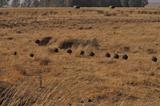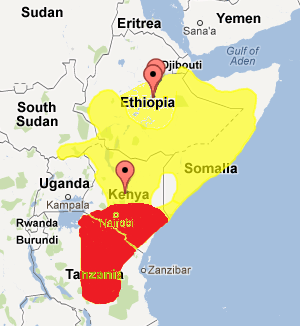Weaver species
Choose different species from drop-down list and press 'Go' button. See Full species list.White-headed Buffalo-Weaver Dinemellia dinemelli
IUCN: Least concern Discovery: 047Categories: cooperative, acacias, fruit, baobab, Nest use, Bubalornis+Dinemellia,
News items about species
Discovery
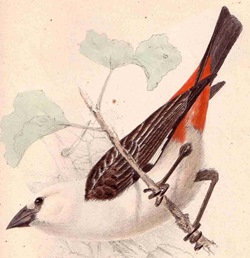
figure from Ruppell 1845 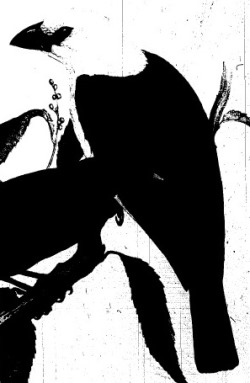
figure from Gray 1849 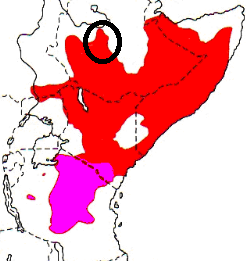
distribution, type locality circled IntroductionThe White-headed Buffalo-Weaver was formally named by Wilhelm Peter Eduard Simon Rüppell, a German naturalist and explorer, especially in north-east Africa.Rüppell obtained specimens of the White-headed Buffalo-Weaver from 2 sources. Martin Bretzka was a German hunter who collected birds for Rüppell. After earlier travels together, Rüppell sent Bretzka back to Ethiopia in 1835 and Bretzka reached Shoa in 1837, where he presumably collected the first White-headed Buffalo-Weaver specimens. Rüppell probably only received these specimens in 1841, and he labelled them as Textor leucocephalus. Bretzka collected at least 2 specimens, which are now in the Senckenberg Museum in Frankfurt. Before describing this species, Rüppell visited the museum of the East India Company in London in 1843, where he saw some more White-headed Buffalo-Weaver specimens. These had been collected by Major Sir William Cornwallis Harris, an English military engineer, artist and hunter. Harris led a British diplomatic mission (1841 to 1843) from Bombay to Sahle Selassie, Negus of Shewa. Harris collected at least 4 specimens of the White-headed Buffalo-Weaver. Harris wrote about his travels in 3 volumes (The highlands of Aethiopia) in which he makes occasional reference to birds, but does not appear to have written about the White-headed Buffalo-Weaver. Harris sent his White-headed Buffalo-Weaver specimens to the East India Company Museum where Thomas Horsfield, curator of the East India Company Museum in London, named the species Textor dinemelli. Horsfield named the species after an unknown collector, Dinemelli, but did not describe the species. The specimens are now in the British Museum. When Rüppell published his description, he chose Horsfield's name rather than his own more descriptive name (leucocephalus = white headed). The first illustration of a White-headed Buffalo-Weaver is a colour painting by Joseph Wolf of a specimen collected by Bretzka, published in the book on north-eastern African birds by Rüppell. The second illustration is by William Mitchell, published in the book by Gray on bird genera, and based on the specimens collected by Harris. Scientific citationTextor dinemelli Ruppell 1845 Syst. Uebers, p.72, pl. 30 Shoa, central Abyssinia.Meaning of namesdinemelli - Named after Dinemelli (fl. 1840) a collector in Ethiopia about whom nothing is known.First English nameThe white-headed Dinemellia (Reichenbach 1863).Alternate namesBoehm's Buffalo Weaver, Dinemelli's (Buffalo) Weaver, Ruspoli's White-headed Buffalo-Weaver, Unyamwesi White-headed Buffalo-Weaver.CollectorMartin Bretzka and Major WC Harris.Date collected1837 (Bretzka) and 1841-43 (Harris).Locality collectedShoa = Shewa, central Ethiopia.Type specimensTwo specimens are in the Senckenberg Museum (Bretzka) and 4 in the British Museum (Harris). |
The above is based on Weaver Wednesday 2, a weekly series about the discovery of each weaver species.
This species text first appeared as
Weaver Wednesday [164] - Discovery [47]: White-headed Buffalo-Weaver on 2015-08-05
1. Basic biology

The sexes are alike and the species colours of white, black and red are unmistakable in the field. Immature birds have pale orange tail coverts, rather than orange-red tail coverts. Distribution.
The White-headed Buffalo-Weaver occurs in eastern Africa. The map (below) is based on Birds of Africa, but central Ethiopia has been added to the distribution here as indicated by Ash J and Atkins J (2009. Birds of Ethiopia and Eritrea. An atlas of distribution).
Two subspecies are recognised: D. dinemelli dinemelli is found from Sudan to Kenya (yellow on the map) - the upperparts are dark brown. D. dinemelli boehmi is found in SE Kenya and Tanzania (red on the map) - the upperparts are black.
Habitat. The White-headed Buffalo-Weaver inhabits dry bush and savanna thornveld, including acacia patches in miombo in Tanzania. It is rare in grassland and riverine vegetation. It occurs in parties of 3-6 birds, and regularly joins mixed-species flocks in open woodland. Food. They forage on the ground and feed mainly on insects but also eat seeds and fruit. Breeding.
The White-headed Buffalo-Weaver is monogamous and may be a co-operative breeder.
There may be a single nest, or several nests which probably belong to a pair. Nests are placed in trees at 2-4 m above the ground. Nests may be placed in trees that have colonies of biting ants, as additional protection from predators. 3-4 eggs are laid, which are greyish white or pale blue, with thick brownish blotches, often forming a cap at the thick end. The incubation period is unrecorded. Chicks are fed by both parents. The nests may be used by Pygmy Falcons and Cut-throat Finches. |
The above is based on Weaver Wednesday, a weekly series about weaver species.
This species text first appeared as
Weaver Wednesday [13]: White-headed Buffalo-Weaver on 2012-09-12
2. Breeding facts
| Pair bond perhaps occasional co-operitive breeding Breeding season probably dependent on local rainfall: Aug-Sept and Dec in Sudan, Apr-Aug in Ethiopia, Feb-Jun and Sept in Somalia, May in Uganda, Feb-Mar, May, Jul and Nov in Kenya, and Dec in Tanzania Nest site usually 2-4 m above ground and resting on branch or suspended from end or underside of branch Nest building Nest built by both sexes Colony size n/a Clutch size 3-4 Egg colour greyish or pale blue, thickly blotched with olive-brown and grey-brown, markings sometimes foming cap at thick end Egg size average 24.6 x I 8 mm (Kenya) Incubation no data on incubation Chicks and nestling period chicks fed by both sexes, nestling period in captivity at least 14 days |
Breeding information based on Handbook of the Birds of the World, Vol. 15.
3. Photos of Weaver Nests
 Vm 28553 |  Vm 13337 |  Vm 7520 |  Vm 5660 |  Vm 5190 |  Vm 3698 |
Thumb-nails of most recent PHOWN records - click on one to see its full record
See all PHOWN records for this species here.
PHOWN (Photos of Weaver Nests) provides valuable info on breeding distribution and colony sizes of weavers.
You can contribute by registering and submitting photos at Virtual Museum webpage.
4. Breeding distribution
Google map showing distribution (For species with small ranges you need to zoom in at the correct area to see the range):
yellow blob - range of weaver species; read more about this here.
![]() - PHOWN records with photos
- PHOWN records with photos
![]() - PHOWN records with no photos (Nest Record Cards, other records)
- PHOWN records with no photos (Nest Record Cards, other records)
![]() - Birdpix records
- Birdpix records
![]() - comments on out of range records, or interesting records
- comments on out of range records, or interesting records
![]() - type locality
- type locality
CLICK on the marker on the map to see individual record details.
5. Range changes
Not South African speciesThe above is based on Weaver Wednesday 3, a weekly series about range changes in South African weaver species.
This species text first appeared as
n/a








